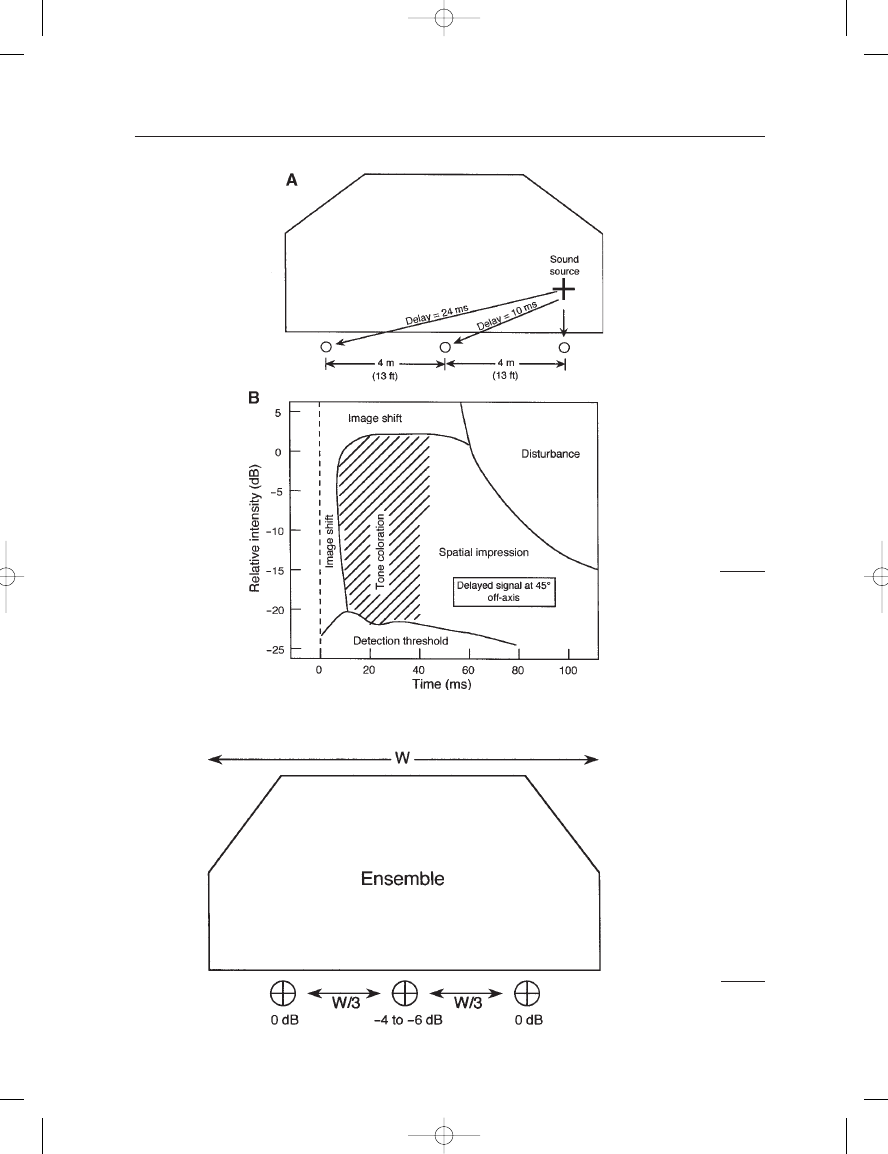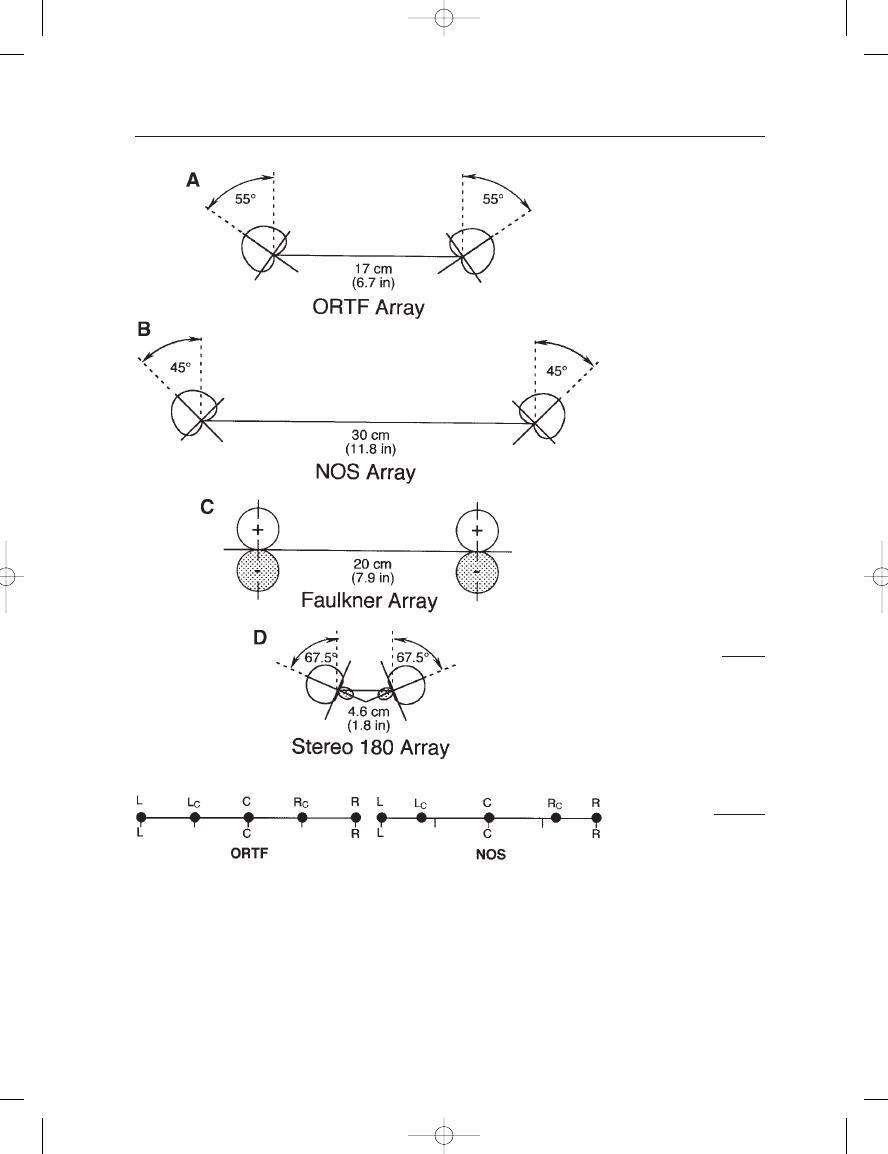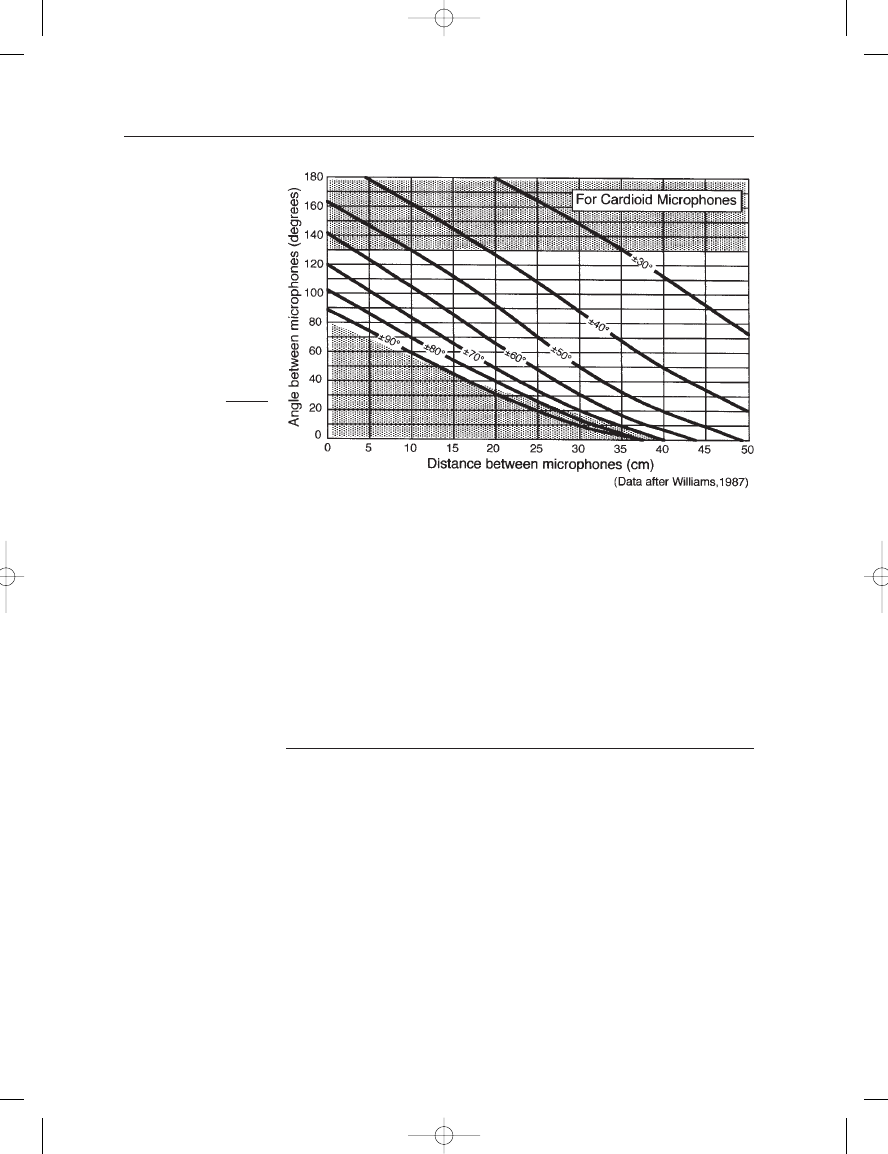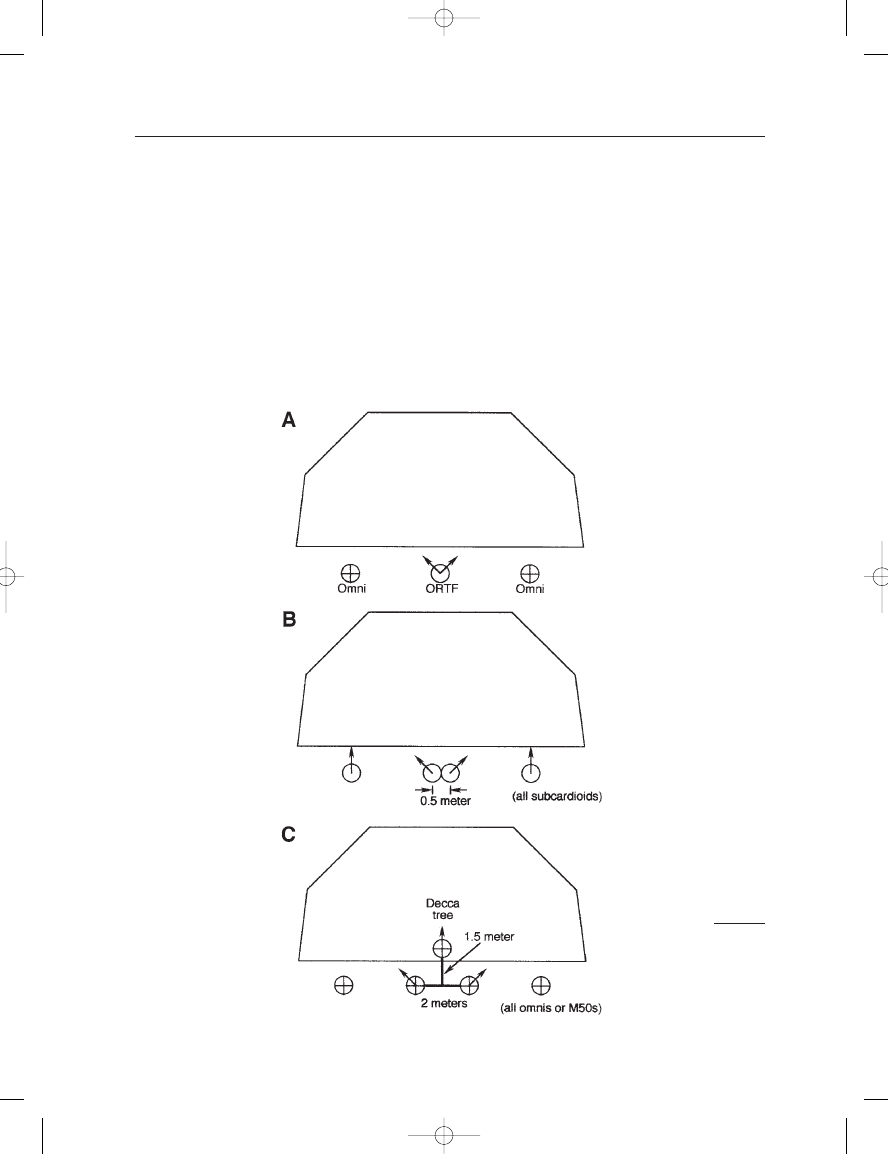ВУЗ: Казахская Национальная Академия Искусств им. Т. Жургенова
Категория: Книга
Дисциплина: Не указана
Добавлен: 03.02.2019
Просмотров: 17304
Скачиваний: 51

THE MICROPHONE BOOK
178
FIGURE 11–11
Widely spaced microphones
may simulate the effect of
early acoustical reflections
(A); Barron’s data on the
subjective role of reflections
in a performance
environment (B).
FIGURE 11–12
Three spaced omnis with
orchestra.
Earg_11.qxd 14/9/04 2:50 PM Page 178

11: Basic Stereophonic Recording Techniques
179
In summary, in spaced omnidirectional recording using two micro-
phones:
1. Microphones are normally spaced no farther apart than about 1 m.
2. The array can be placed relatively close to a small group of per-
formers, creating a good sense of intimacy while retaining an
impression of room ambience.
3. The technique is useful primarily when precise imaging of instru-
ments on the stereo sound stage is not essential.
In spaced omnidirectional recording using three microphones:
1. Wide spacing of microphones creates the effect of added early
acoustical reflections, thus enhancing a sense of ambience.
2. The center microphone “locks” the middle of the ensemble in
place, but often with relatively little precise localization.
3. Ample pickup of room reflections and reverberation retains a good
sense of acoustical space, along with significant direct sound from
the ensemble.
NEAR-COINCIDENT RECORDING TECHNIQUES
Near-coincident techniques employ a pair of directional microphones,
closely spaced and splayed outward, and as such combine some of the
attributes of both coincident and spaced microphone techniques. Some
options are shown in Figure 11–13. The near-coincident microphone
pairs combine both amplitude and delay effects in producing a stereo
sound stage. They are useful in a wide range of acoustical settings and
may be altered in both spacing and splay angle as required. Actually,
there are innumerable possible configurations, and the four shown here
are examples of some that have been described in the literature.
The ORTF (Office de Radio-Television Diffusion Française) tech-
nique was developed by the French Broadcasting organization, while the
NOS (Nederlandsch Omroep Stichting) technique was developed by the
Dutch broadcasting organization. The Faulkner and Olson (1979)
Stereo-180 arrays were developed by independent recording engineers.
Many engineers and musicians favor the ORTF array in particular and
use it in place of the more traditional coincident cardioid array (Ceoen,
1970). Figure 11–14 shows a Franssen analysis of localization properties
of the ORTF and NOS arrays.
WILLIAMS’ SUMMARY OF STEREO SPACED AND SPLAYED
CARDIOIDS
Since the formalization of the ORTF near-coincident approach more
than 30 years ago, many engineers have experimented with their own
splay angles and microphone separation, perhaps in an effort to define
Earg_11.qxd 14/9/04 2:50 PM Page 179

THE MICROPHONE BOOK
180
FIGURE 11–13
Near-coincident pairs.
ORTF (A); NOS (B);
Faulkner (C); Olson (D)
(cross-hatching indicates
antiphase pickup relative to
frontal lobe).
FIGURE 11–14
Franssen analysis of
ORTF and NOS pairs.
their own unique stereo signature. Williams has analyzed many micro-
phone patterns in various splay angles and separation with the aim of
defining reasonable bounds on their performance. The data shown in
Figure 11–15 shows the useful range of cardioid microphone separation
and splay angle (Williams, 1987). The effective recording angles are indi-
cated on the curves themselves for a variety of separation and splay angle
values. Those values in the crosshatched areas are not recommended
Earg_11.qxd 14/9/04 2:50 PM Page 180

11: Basic Stereophonic Recording Techniques
181
because of problems in stereo imaging, ranging from insufficient stereo
separation to a tendency for separation to be polarized at the loud-
speakers.
In summary, near-coincident microphone performance:
1. Combines the image specificity of coincident arrays with the
enhanced sense of image spatiality imparted by spaced micro-
phones.
2. Allows considerable leeway in choice of splay angle and micro-
phone spacing for modifying the recorded perspective.
MIXED STEREO MICROPHONE ARRAYS
Most engineers who make commercial recordings use mixed arrays in
which a central pair, either coincident or near coincident, is combined with
a flanking omnidirectional pair. The combination provides excellent flexi-
bility and allows the engineer to alter perspectives in the orchestra without
necessarily making adjustments in the microphone positions themselves.
For example, a shift from a close-in perspective to a somewhat more
distant perspective can be made merely by altering the amount of the
spaced pair in the overall mix. Care must be taken not to exceed a level
range here of perhaps
1.5 to 2 dB, otherwise the changes may be too
apparent. Of course it goes without saying that such changes, if of a run-
ning nature throughout a large work, must be musically pertinent in the
first place.
Some of the more often used setups of this type are shown in
Figure 11–16. The ORTF-plus-flanking-omnis setup is shown at A. As a
FIGURE 11–15
Williams’ data showing
useful combinations of
separation and splay angle
for a cardioid microphone
pair.
Earg_11.qxd 14/9/04 2:50 PM Page 181

THE MICROPHONE BOOK
182
matter of taste, some engineers may replace the ORTF pair with a pair
of widely splayed (120
) hypercardioids, and the omnis may be replaced
with subcardioids in especially live rooms.
The variation shown at B makes use of four subcardioids. The cen-
ter pair may be spaced up to 0.5 meter (20 in), and the splay angle
between them set in the range of 120
. This mixed array provides good
flexibility, but overall it tends to pick up considerable room ambience
and reverberation.
The so-called “Decca tree” is shown at C. Developed by the English
Decca Record Company in the 1950s, the array makes use of three iden-
tical microphones on a “tree” in the center, with the middle microphone
gain set slightly lower than the left and right microphones. Flanking
FIGURE 11–16
Mixed arrays: ORTF plus
flanking omnidirectional
microphones (A); four
subcardioids (B); the Decca
tree (C).
Earg_11.qxd 14/9/04 2:50 PM Page 182